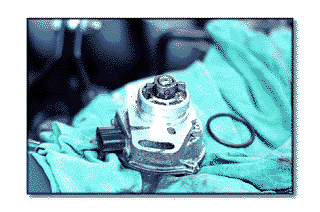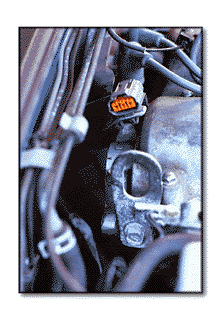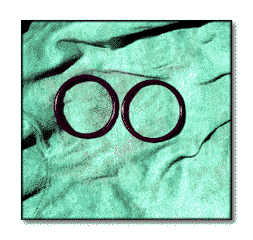Crank-angle sensor oil seal replacement
by Tim Reynolds
This
information is provided as a courtesy only and the author assumes no
responsibility for any misfortune arising from its use or misuse. Also, this
information is based on the author's personal experience with his 1991 1.6 litre
Miata. The '94 and later Miatas have a different placement of the Crank Angle
Sensor and this information does not apply.
 The crank-angle sensor is a device to tell the
engine when to fire the spark plugs. On my car it actually attaches to the intake
valve camshaft. (See next image.) It senses the position of the intake cam, from
which the car can determine the position of the crankshaft, and the computer can
tell the cylinders to fire. In the days before engine computers (ECUs) this job
was done by the distributor. By rotating the the sensor relative to the intake
camshaft I can alter the engine's base ignition timing. It was during one of these
pretty routine adjustments that I noticed a lot of fresh oil around the sensor.
A leaky oil seal here seemed the likely culprit of the oil loss my car had been
suffering.
The crank-angle sensor is a device to tell the
engine when to fire the spark plugs. On my car it actually attaches to the intake
valve camshaft. (See next image.) It senses the position of the intake cam, from
which the car can determine the position of the crankshaft, and the computer can
tell the cylinders to fire. In the days before engine computers (ECUs) this job
was done by the distributor. By rotating the the sensor relative to the intake
camshaft I can alter the engine's base ignition timing. It was during one of these
pretty routine adjustments that I noticed a lot of fresh oil around the sensor.
A leaky oil seal here seemed the likely culprit of the oil loss my car had been
suffering.
 Changing the oil seal on the crank-angle sensor
turned out to be remarkably easy. First I had to disconnect a couple of electrical
interfaces (identified by the orange bits in the picture to left) in order to
give myself some room to work. Then I marked the current position of the sensor
with a permanent marker. After removing the single mounting bolt, the sensor
itself simply pulled right out. The most difficult part of removing the sensor
was manhandling it between valve cover and all the electrical lines around there.
Changing the oil seal on the crank-angle sensor
turned out to be remarkably easy. First I had to disconnect a couple of electrical
interfaces (identified by the orange bits in the picture to left) in order to
give myself some room to work. Then I marked the current position of the sensor
with a permanent marker. After removing the single mounting bolt, the sensor
itself simply pulled right out. The most difficult part of removing the sensor
was manhandling it between valve cover and all the electrical lines around there.
The oil seal was definitely leaking. I noticed a coating
of fresh oil on the surfaces that mated to the valve cover. At this point, if
I'd been thinking ahead, I would've found a way to mark the position of the
"dogs" that fit into the end of the camshaft. Doing so would've made re-installation
much simpler.
 Once the sensor was out of the car it was simple
affair to pull the old oil seal off and put a new one on. As this picture shows,
the oil seal is a simple rubber O-ring. (3.50US$ at my local Mazda dealer) The
thing that this picture doesn't adequately show is that the old O-ring (on the
right) was crushed flat on both the inner and outer diameters, making it sit
exactly flush with the sensor/valve cover mating surfaces. Oil was free to sneak
right by. (I'm going to try to get hold of a macro lens and see if I can get
a picture showing what I mean.)
Once the sensor was out of the car it was simple
affair to pull the old oil seal off and put a new one on. As this picture shows,
the oil seal is a simple rubber O-ring. (3.50US$ at my local Mazda dealer) The
thing that this picture doesn't adequately show is that the old O-ring (on the
right) was crushed flat on both the inner and outer diameters, making it sit
exactly flush with the sensor/valve cover mating surfaces. Oil was free to sneak
right by. (I'm going to try to get hold of a macro lens and see if I can get
a picture showing what I mean.)
Reinstallation was simply a reversal of the removal steps.
The most difficult thing was getting the "dogs" lined up with the slots they
mated with on the camshaft. Luckily Mazda was smart enough to design things
such that you don't need to worry about getting the sensor mis-aligned by 180
degrees. It only goes in one way. I finally got everything lined up and pushed
home, re-fitted the retaining bolt and connected all the electricals.
Notes from Diamond Dave: Taking the cover off the CAS is actually very
helpful at ensuring the "dogs" remain aligned while sliding the CAS
into the housing. I had an issue replacing the cover at first. Then I used a
flat blade screwdriver bit (from my Snap-On ratcheting screwdriver) and a 1/4
box wrench as a sort of perpendicular nut driver. I didn't need to remove the
heater hoses and, as long as I went slowly, there was no risk of stripping the
screws.
Use a high quality grease on the O-ring.
 Changing the oil seal on the crank-angle sensor
turned out to be remarkably easy. First I had to disconnect a couple of electrical
interfaces (identified by the orange bits in the picture to left) in order to
give myself some room to work. Then I marked the current position of the sensor
with a permanent marker. After removing the single mounting bolt, the sensor
itself simply pulled right out. The most difficult part of removing the sensor
was manhandling it between valve cover and all the electrical lines around there.
Changing the oil seal on the crank-angle sensor
turned out to be remarkably easy. First I had to disconnect a couple of electrical
interfaces (identified by the orange bits in the picture to left) in order to
give myself some room to work. Then I marked the current position of the sensor
with a permanent marker. After removing the single mounting bolt, the sensor
itself simply pulled right out. The most difficult part of removing the sensor
was manhandling it between valve cover and all the electrical lines around there.
 The crank-angle sensor is a device to tell the
engine when to fire the spark plugs. On my car it actually attaches to the intake
valve camshaft. (See next image.) It senses the position of the intake cam, from
which the car can determine the position of the crankshaft, and the computer can
tell the cylinders to fire. In the days before engine computers (ECUs) this job
was done by the distributor. By rotating the the sensor relative to the intake
camshaft I can alter the engine's base ignition timing. It was during one of these
pretty routine adjustments that I noticed a lot of fresh oil around the sensor.
A leaky oil seal here seemed the likely culprit of the oil loss my car had been
suffering.
The crank-angle sensor is a device to tell the
engine when to fire the spark plugs. On my car it actually attaches to the intake
valve camshaft. (See next image.) It senses the position of the intake cam, from
which the car can determine the position of the crankshaft, and the computer can
tell the cylinders to fire. In the days before engine computers (ECUs) this job
was done by the distributor. By rotating the the sensor relative to the intake
camshaft I can alter the engine's base ignition timing. It was during one of these
pretty routine adjustments that I noticed a lot of fresh oil around the sensor.
A leaky oil seal here seemed the likely culprit of the oil loss my car had been
suffering.
 Once the sensor was out of the car it was simple
affair to pull the old oil seal off and put a new one on. As this picture shows,
the oil seal is a simple rubber O-ring. (3.50US$ at my local Mazda dealer) The
thing that this picture doesn't adequately show is that the old O-ring (on the
right) was crushed flat on both the inner and outer diameters, making it sit
exactly flush with the sensor/valve cover mating surfaces. Oil was free to sneak
right by. (I'm going to try to get hold of a macro lens and see if I can get
a picture showing what I mean.)
Once the sensor was out of the car it was simple
affair to pull the old oil seal off and put a new one on. As this picture shows,
the oil seal is a simple rubber O-ring. (3.50US$ at my local Mazda dealer) The
thing that this picture doesn't adequately show is that the old O-ring (on the
right) was crushed flat on both the inner and outer diameters, making it sit
exactly flush with the sensor/valve cover mating surfaces. Oil was free to sneak
right by. (I'm going to try to get hold of a macro lens and see if I can get
a picture showing what I mean.)